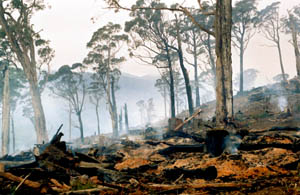
One in 20 bushfires started by logging industry practices in State forests.
Serious bushfires have resulted from logging practices; these include fires escaping from logging coupe burn-offs, and fires started by logging machinery exhausts and chainsaws. Additionally, the Department of Sustainability and Environment (DSE) admits that road construction for the purposes of logging may be a significant source of ignition.
The most recent example is the very serious fire that burnt over 6,000 ha near Cann River in December 2009 started by logging equipment machinery at a logging coupe. The fire kept re-igniting, taking weeks to control. It was very fortunate that this bushfire did not destroy the Cann River township.
It is only when these bushfires started by the logging industry get large and threaten towns or water catchments, they are reported in the news.
The Age(19 December 2009): Fire crews battle Cann River blaze.
ABC Radio news (17 October 2006): Regeneration burns blamed for Erica fires.
The Age(10 May 2004): Logging fires hit catchments.
A practice after clearfell logging is to burn the area logged to promote regrowth. Below are 2006 photo's of smoldering logs after a routine logging burn-off. They were left unattended for months and then ignited into a major bushfire that burnt out 600ha within the Tanjill and Tyers water supply catchments. This is the logged area referred to in the ABC Radio news story of 2006 above. This logging practice put the nearby Melbourne's domestic water supply catchments at risk.
Click images to enlarge:
 |
 |
Calculation to estimate fires starts attributed to the native forest logging industry.
DSE has a huge amount of information about fire starts on public land (download pdf). However the way
information is presented is vague. The number of fires starts attributed directly to logging industry practices is not specifically calculated.
Below is an example of fire start information provided by the Environment and Natural Resources Committee, Parliament of Victoria Inquiry into the Impact of Public Land Management Practices on Bushfires in Victoria (June 2008).
Given that 63% of prescribed burns are post-logging burns
then it is reasonable to attribute 3% of wildfire starts as escapes from post-logging burns. Combined
with machinery fire starts (2%) this indicates that
5% or one in 20 bushfires started
in State forests are by logging industry practices.
Don't know the meaning of a word? Check the glossary.
